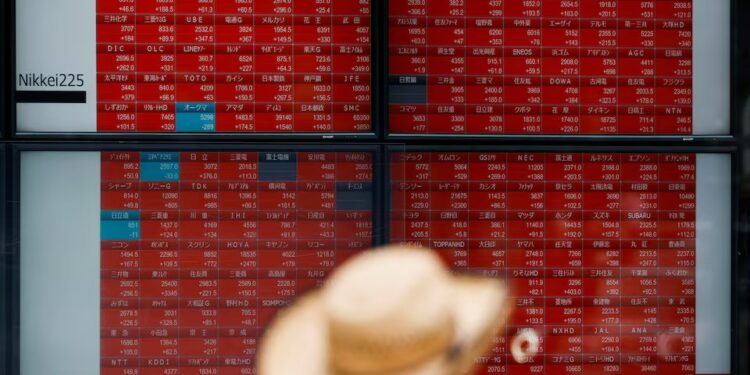Japanese stocks jumped at the open on Tuesday, underpinning a recovery across battered Asian share markets, after central bank officials said all the right things to soothe investor nerves.
The Nikkei soared more than 10% to above 34,500, rebounding sharply from its 31,458 close on Monday. The index had plummeted 12.4% in the previous session in its worst sell-off since the 1987 Black Monday crash.
MSCI’s broadest index of Asia-Pacific shares outside Japan was up 2.0%.
Wall Street also looked steadier with S&P 500 futures rebounding 1.5%, while Nasdaq futures rose 2% and the pan-region Euro Stoxx 50 futures advanced 1.24%.
The S&P 500 had lost 3.00% on Monday, with the Nasdaq Composite slumping 3.43%, extending a recent sell-off as fears of a possible U.S. recession spooked global markets.
Yields on 10-year Treasury notes were back at 3.84%, having been as low as 3.667% at one stage.
Federal Reserve officials did their best to reassure markets with Fed San Francisco President Mary Daly saying it was “extremely important” to prevent the labor market tipping into a downturn. Daly said her mind was open to cutting interest rates as necessary and policy needed to be proactive.
“The Nikkei’s enjoying a decent retracement against Monday’s plunge, as comments from the Fed’s Daly and a stronger-than-expected ISM services report soothed fears of a panic Fed cut next week,” said Matt Simpson, a senior market analyst at City Index in Brisbane.
“But this is not exactly a risk-on rally. And we are not yet sure if this is just a breather between water-boardings or there is more pain to follow.”
Currencies also seemed to be reversing some of Monday’s sharp moves, as the dollar edged up to 145.64 yen , having sunk 1.5% on Monday to as deep as 141.675. The yen has shot higher in recent sessions as investors were squeezed out of carry trades, where they borrowed yen at low rates to buy higher yielding assets.
The dollar pared its losses on the safe-haven Swiss franc, holding at 0.8546 francs from a low of 0.8430.
Treasury yields had also come off their lows, in part in reaction to a rebound in the U.S. ISM services index to 51.4 for July. In particular, it employment index jumped 5 points to 51.1, suggesting last week’s payrolls report may have overstated the weakness in the labour market.
“Gauging the bottom of such historic selloffs is complicated and investors will most likely remain cautious before pouring capital back into equity markets,” said Boris Kovacevic, Austria-based global macro strategist at payments firm Convera.
“However, the dollar-yen pair has now fallen 12% since peaking five weeks ago and is in highly oversold territory. The yen is therefore vulnerable to any upside surprises in U.S. macro data leading investors to reconsider the recession trade. This would help Japanese equities stabilize,” he said.
Market expectations the Fed would cut by 50 basis points at its September meeting remained intact, with futures, opens new tab implying a 71% chance of such an outsized move.
The market has around 100 basis points of easing priced in for this year, and a similar amount for 2025.
In precious metals, gold failed to get a safe haven bid amid talk investors were taking profits to cover losses elsewhere. Spot gold stood at $2,409 an ounce after losing 1.52% overnight.
In energy markets, oil prices bounced early Tuesday as news that several U.S. personnel were injured in an attack against a military base in Iraq stoked fears of a wider conflict.
U.S. West Texas Intermediate crude futures CLc1 climbed $1.18, or 1.6%, to $74.12 per barrel.

Source: Reuters



Recent Comments